This morning we visited the Givhans Baptist Church as I mentioned in a previous post. It was quite small – only about 30-40 in attendance and five of those were in the choir. But Blaine had read that they were just coming off a week of revival, so that may have had something to do with the numbers. They seem to be fairly active in the community – collecting for less fortunate, a Christmas play, admonishments to reach out to others, etc. They also seem to value prayer, which is a great thing. Their prayer list was two pages long in the bulletin – front and back of an 8 ½ x 11 paper (large print). Who are all these people? I think one is someone’s waitress at a local Shoney’s. The paper said “Jessica @ Shoney’s” in the cancer section. They gave us a gift bag for visiting. Unfortunately, we threw out the cup. We just have no use for it. ☹
After lunch we headed out for another history lesson. I hope you like history. There’s a lot of it around here and we love it. 😊
Today was Dorchester Park. It’s a State Historic Park donated to the State in 1969 because of it’s significance in the 1700’s as an important crop/port area. I couldn’t find out who donated it. I tried.
And tried.
And tried.
Until I was tired of trying.
The colonists named it Dorchester after Dorchester, England, where the founders were originally from. Some of them were from the Mayflower sailing in 1620! Did you know they named the town they settled in Massachusetts Dorchester? I had no idea! Anyway, when some came to South Carolina (not named yet, of course), they called the place they settled Dorchester. They must have really liked that name – – or they had no creativity at all.
This Dorchester (4,050 acres) was settled in 1696 and abandoned after the Revolutionary War. By 1770, the village had 40 homes, a school, a library, a mill site and a monthly fair. There was also a substantial Congregationalist church and a fort overlooking the river. The fort first fell to the British when Charles Towne fell in 1780. The British held the fort until 1781 when they lost the Revolutionary War. However, before they left town, they burned everything and drove the residents away. By the early 1800’s there wasn’t much left because many of the bricks that didn’t burn were scavenged by others in the area to build their homes, etc.
Then, the Great Charleston Earthquake of 1886 destroyed even the ruins – except for the old church tower, its graveyard and the walls of the fort. It was covered by brush and trees until the “Colonial Dames of America” showed up in the 1920’s and began to clear debris away.
The State Park encompasses the 50 acres that was set aside for the town itself – kinda like a ‘downtown’ area. They provide an 8 1/2 x 11 paper that lists information on the front and back, for a self-guided walking tour.
We headed towards the bell tower first as that seemed to be the most interesting thing at first glance.


An artist’s rendition of a church depicting what the Park people believe to be similar to the original church and bell tower.

The side of the remaining bell tower

Here’s what we consider the front of the bell tower, but it was probably against the church building . . . as far as we can tell anyway. : )


This one and the next, show part of the inside
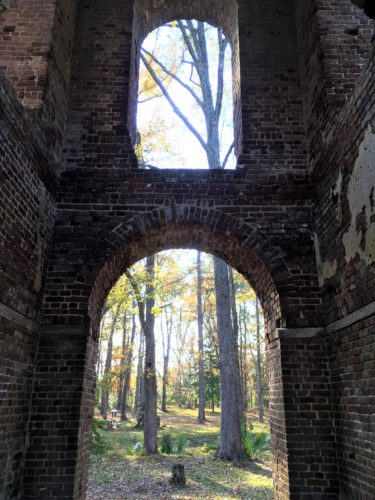

This one was taken right before we left the Park.
I think it shows more of the burn pattern left from the British torching the town.
And guess what?? There was a CEMETERY in front of it! Bet you’re getting really tired of these aren’t you? Just wait till we get to Na-Lens! (New Orleans) Most likely there’ll be more before that . . .
The paper the Park provided had all the information I’ve listed on the pictures.

James Postell (during the Revolution, British soldiers supposedly scarred the tombstone of this wealthy planter by using it as a butcher block.) It says:
In Memory of James Postell Esquire
A Sincere Christian, an affectionate Husband, an indulgent Parent , and a faithful Friend
He died 8th April 1773, Aged 51 years, Much lamented by all his Friends & Relations, but his better part yet lives.
(FYI – that means his soul is in Heaven)

John Joor, Jr. (Son of John Joor. His will requested that a brick wall enclose the family plot; the remnants of the wall are still visible.)
Sacred Tot he Memory of Mr. John Joor Junr, who Departed this life, Decemr, 19th 1790, Aged 50 years and 8 months.
We didn’t see the remnants of this wall.

John Joor, Sr. (Planter and merchant. His marker is the oldest in the cemetery and the only one with a footstone.)
Here lies the body of JOHN JOOR Esqr, who died Septr. 15th 1772, Aged 56 years & 2 months

Charles B. Ladson (A planter who acquired the site of Dorchester after the town was abandoned.)
THIS STONE marks the spot where are deposited the remains of CHARLES B> LADSON, Esq. who died 1st April 1833, aged 47 yrs. 4 mo:4days. His private charities & public usefulness will cause his death to be long lamented in this vicinity, His friends will find his place not readily filled in their hearts and will fondly cherish the recollection of his many virtues by which he was justly endeared to them.

Seth Prior (A local planter and merchant.)
Sacred to the memory of Seth Prior who departed this life on teh 16th day of June 1789 Aged 63 Years 8 Months and 16 days. Also by him lieth His Wife and Two small Children.

Seth Thornton Prior (Eldest son of Seth Prior, he operated a tavern on Dorchester Road.)
This stone was broken by Hurricane Hugo in 1989.
Sacred to the memory of Major SETH THORNTON PRIOR who depart this life on the 1st of December 1830, After a long and painful illness in the 49th year of his age; leaving a Widow and two Sons to lament their irreparable loss. By his side lie the remains of five of his children.
How happy are the souls above
From sin & sorrow free!
With Jesus they are now at rest
And all his glory see.

Margaret Autrobus Young (widow of a planter from nearby Goose Creek.)
Sacred To the Memory of Mrs. Margaret Autrobus Young, Wife of Mr. Thomas Young. She was born in Great Britain A.D. 1727. At Six years of age she came to America. And upwards of Sixty years, Resided in Charleston, S.C. During nearly fifty of those years, She was a steady and ornamental member of the Indpt. Or Congegl. Church. With exemplary resignation, And good hope in Christ, She died April 6th. 1808: Aged Eighty years & eleven months. Like Martha careful, & like Mary wise.

Cornelius Dupont (Son-in-law of Louisa Hutchinson. His will requested that the family plot here be enclosed with the brick wall.)
TO the memory of Dr. CORNELIUS DUPONT who departed this life on the 21st of July 1843, in the 58th year of his age.
Here’s a couple of pictures of the wall, before we move on:

There’s Blaine – irreverently standing on a tombstone as he reads aloud to me.
Oh. Well, maybe he’s just standing beside it. : )

Mary H. Whitaker (Daughter of Louisa Hutchinson, she was married to Dr. Stubbins Ffirth and later to Rev. Daniel K. Whitaker.)
Broken by Hurricane Hugo, 1989.
SACRED to the Memory of Mrs Mary H. Whitaker, who departed this life on the 19th October 1847, aged 57 years. A devoted wife, a fond mother, a kind mistress, a faithful friend, an enlightened and practical Christian, she adorned every relation of life with grace, dignity and goodness, and has left behind her, fond and endearing recollections, which neither time nor death will ever obliterate from the heart of the memory.
There was no stone for Mary. I guess it was too badly damaged in the Hurricane.

Louisa Houseal (Possibly the daughter of Louisa Hutchinson)
Broken by Hurricane Hugo, 1989
Sacred to the Memory of Mrs. LOUISA C> HOUSEAL the amiable parner of Dr. JOHN G> HOUSEAL who departed this Life on the 7th January 1814 aged 39 years 2 months & 16 days.

Louisa Hutchinson (The first of four generations of Hutchinsons buried here. She died in 1797 shortly after giving birth to a son.)
Sacred to the Memory of Louisa Hutchinson, Consort of Mathias Hutchinson Esqr, Who Died on the 14th May, In the 43d. Year of Her Age, She was an amiable and affectionate Wife, a tender Parent, and a sincere friend: a humane and indulgent mistress. Her last moments were sweetened with consolatory reflections on this well spent Life.

Tombstone fragment – unknown

Stubbins Ffirth (First husband of Mary hutchinson Whitaker. A physician, Dr. Ffirth experimented on himself to prove that yellow fever was not contagious.
(FYI – it’s spread by mosquitoes)
Sacred To the Memory of Stubbins Ffirth, M.D. Who departed this life at Ffirthville, St. Paul’s Parish, S.C. On the 4th of July 1820 In the Thirty-Ninth year of his age. As a Husband and Father, he was Kind and affectionate, as a Master, he was just and indulgent. As a friend, he was Sincere And true; as a Physician He was eminent in his profession Had an extensive practice Was prompt and ready at every call Whether proceeding from the poor Or the rich, as Thousands Can testify: As a Christian he was devout And at the same time liberal In his opinions. NEXT, to him lies his Second Son Caspar Wistar. This monument is erected by his Only surviving Son, who revives His Memory.

Joseph Hall Waring Hutchinson & Mary Freer Hutchinson (A third-generation Hutchinson and his wife.)
JOSEPH HALL WARING HUTCHINSON 1833-1877. HIS WIFE MARY FREER 1841-1883

Edward H. Freer & Esther Rivers Freer (The parents of Mary Freer Hutchinson)
EDWARD H. FREER 1815-1880. HIS WIFE ESTHER RIVERS 1817-1894

W.J. Sineath (Farmer, carpenter, and phosphate mining company manager.)
DEDICATED TO THE MEMORY OF W.J. Sineath WHO DEPARTED THIS LIFE AUG. 16, 1907 We shall meet again at the resurection morn. “Wife”.

Effie Sineath (One of eleven children of W.J. and Georgianna Moore Sineath.)
IN MEMORIAM EFFIE DAUGHTER OF W.J. & G. M. SINEATH DIED MAY 12, 1905.

Georgianna Moore Sineath (Wife of W.J. Sineath. Hers is the most recent stone in the cemetery.)
Mrs. G.M. SINEATH WIFE OF W.J. Sineath DIED OCT. 13, 1920 IN THE 88TH YEAR OF HER AGE MOTHER
Here’s what we found in the rest of the Park –
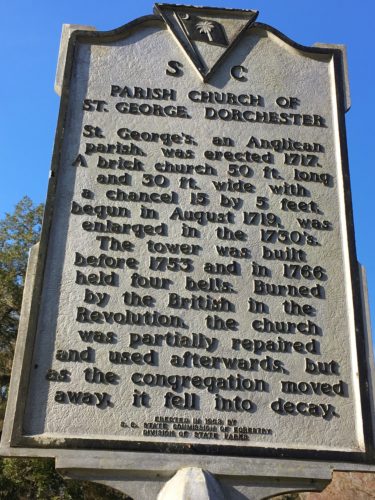


This is actually the entrance to the Park. It’s made with oyster shells.


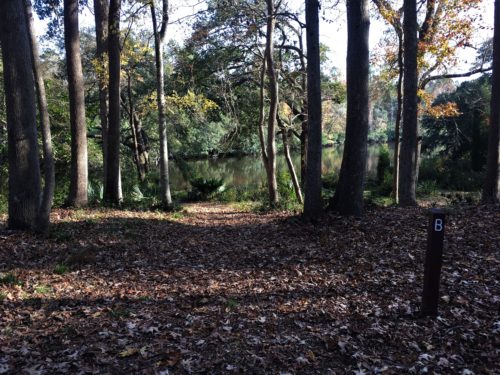



NOW you tell me! After I was just standing on the bank!







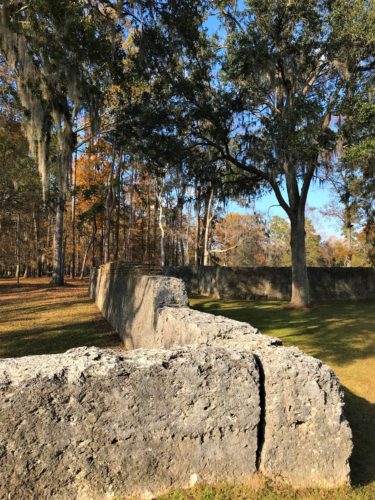


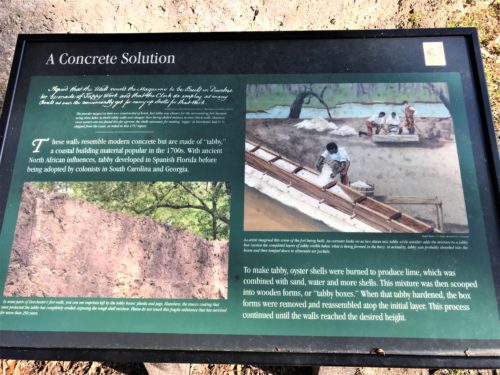


You can still see the form lines in the wall.

Another curious visitor


A house used to be here.


Current archaeological dig site.

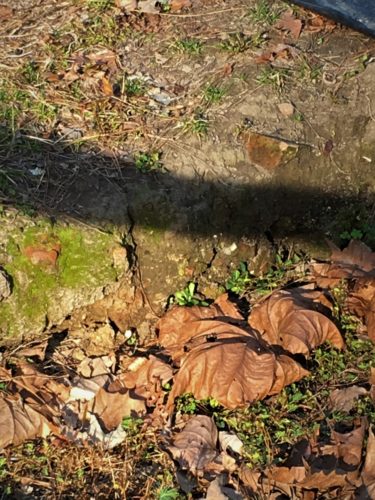
You can see some of the bricks they’ve uncovered.

They had these random street signs set up to show where the streets used to be.

That’s it for Dorchester.
By the time we finished, we thought it was still a bit early to head home and we were craving more than a slow stroll. We happened to drive by another park sign, turned around, and with some effort pulled in and parked. This one was a City Park founded by a private citizen and according to his will, it is to “remain in perpetuity”. Do you know what that means? For those who don’t, it means it has to stay a park for the people forever (or more specifically – eternally). Here, we were able to pick up the pace a bit, with stops occasionally to read (or skim) the nature info boards.
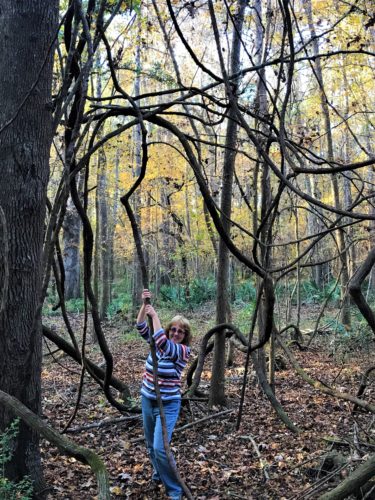
TONS of vines in this park!



I didn’t know all these. Do you?



Look how these are intertwined.


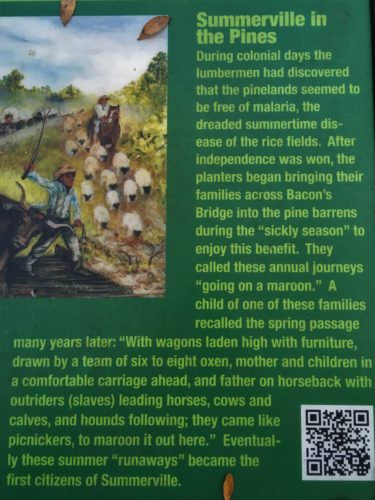




Hard to imagine that was here. . .

NOW we can head home. : )
